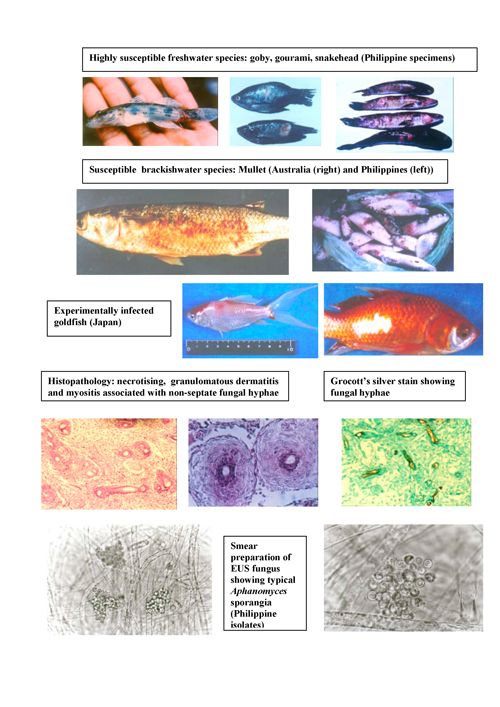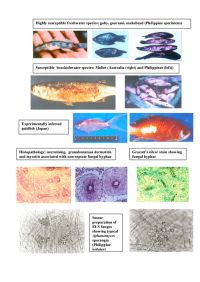Epizootic ulcerative syndrome: Disease card
26 August 2004 | 1269 Downloads | .pdf | 234.61 KB | Freshwater finfish, Health and Biosecurity
Epizootic ulcerative syndrome (EUS) is a seasonal epizootic condition of wild and farmed, fresh- and brackishwater fish. Of complex infectious aetiology, it is characterised by the presence of invasive Aphanomyces infection and necrotising ulcerative lesions typically producing a granulomatous response. The disease is now endemic in South-east and south Asia, and has recently extended to West Asia. EUS is indistinguishable from red spot disease of eastern Australia and mycotic granulomatosis of Japan.
EUS has been reported to occur in over 100 freshwater fish species and, to a lesser extent, in brackishwater fish. It is more prevalent in snakeheads and barbs, while Chinese carps are rarely affected, and tilapias seem to be resistant. The primary causative agent of EUS appears to be one or more members of the fungal genus Aphanomyces. Isolates from EUS-infected fish in South-east and south Asia have recently been desrcibed as Aphanomyces invaderis, while in Japan, A. piscicida was described as the primary cause of mycotic granulomatosis. Recent studies have shown that these two species are indistinguishable culturally and pathogenically, and will probably prove to be conspecific. Additionally, the opportunistic bacteria Aeromonas hydrophila and A. sobria and one or more of a number of viruses may also be involved in the pathogenesis of EUS.
Diagnosis is based on clinical signs and histological evidence of the typical aggressive invasiveness of the non-septate fungal hyphae, within the context of high mortalitiy. Isolation of the fungus allows its characteristic growth profile to be used as an aid to identification.
Control of EUS in natural waters is probably impossible. In outbreaks occurring in small, closed water bodies, liming of water and improvement of water quality, together with removal of infected fish, is often effective in reducing mortality.
Creative Commons Attribution.

